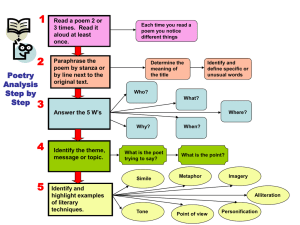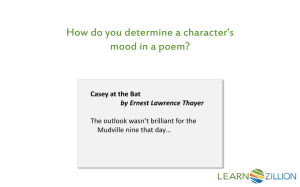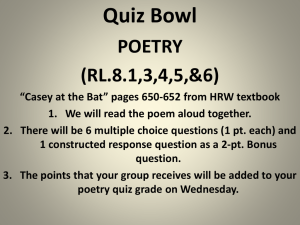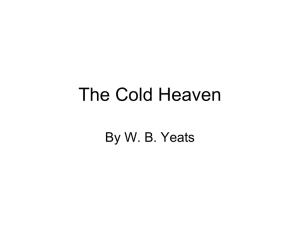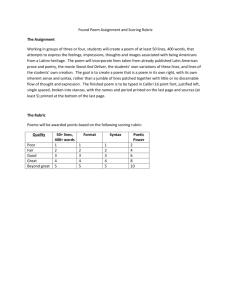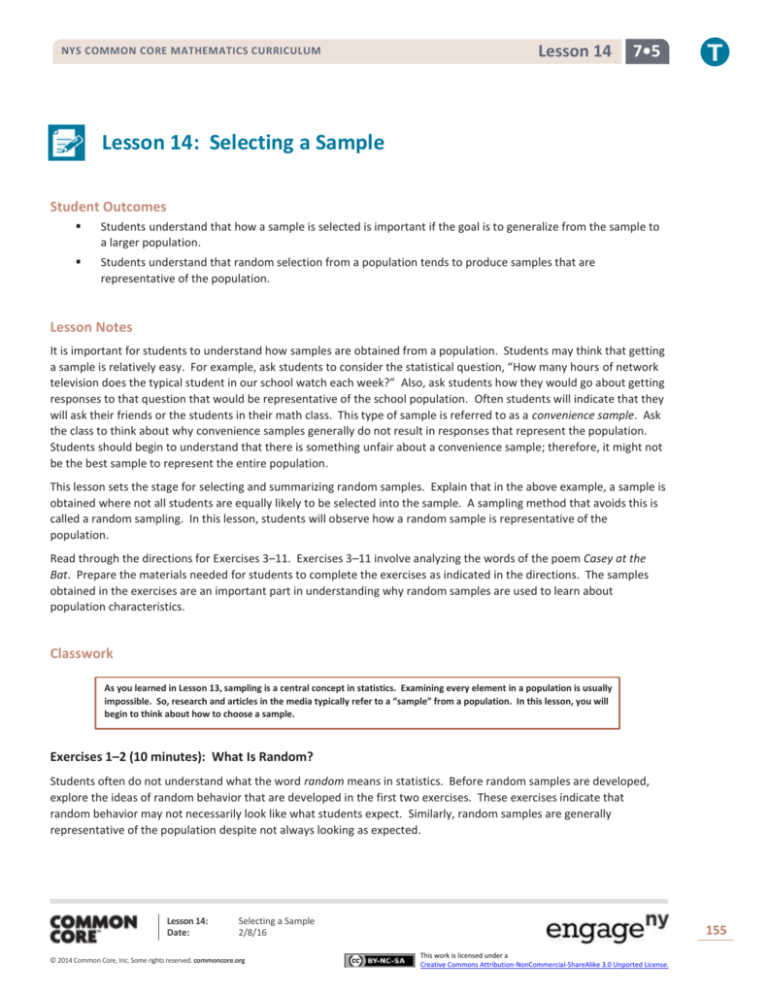
NYS COMMON CORE MATHEMATICS CURRICULUM
Lesson 14
7•5
Lesson 14: Selecting a Sample
Student Outcomes
Students understand that how a sample is selected is important if the goal is to generalize from the sample to
a larger population.
Students understand that random selection from a population tends to produce samples that are
representative of the population.
Lesson Notes
It is important for students to understand how samples are obtained from a population. Students may think that getting
a sample is relatively easy. For example, ask students to consider the statistical question, “How many hours of network
television does the typical student in our school watch each week?” Also, ask students how they would go about getting
responses to that question that would be representative of the school population. Often students will indicate that they
will ask their friends or the students in their math class. This type of sample is referred to as a convenience sample. Ask
the class to think about why convenience samples generally do not result in responses that represent the population.
Students should begin to understand that there is something unfair about a convenience sample; therefore, it might not
be the best sample to represent the entire population.
This lesson sets the stage for selecting and summarizing random samples. Explain that in the above example, a sample is
obtained where not all students are equally likely to be selected into the sample. A sampling method that avoids this is
called a random sampling. In this lesson, students will observe how a random sample is representative of the
population.
Read through the directions for Exercises 3–11. Exercises 3–11 involve analyzing the words of the poem Casey at the
Bat. Prepare the materials needed for students to complete the exercises as indicated in the directions. The samples
obtained in the exercises are an important part in understanding why random samples are used to learn about
population characteristics.
Classwork
As you learned in Lesson 13, sampling is a central concept in statistics. Examining every element in a population is usually
impossible. So, research and articles in the media typically refer to a “sample” from a population. In this lesson, you will
begin to think about how to choose a sample.
Exercises 1–2 (10 minutes): What Is Random?
Students often do not understand what the word random means in statistics. Before random samples are developed,
explore the ideas of random behavior that are developed in the first two exercises. These exercises indicate that
random behavior may not necessarily look like what students expect. Similarly, random samples are generally
representative of the population despite not always looking as expected.
Lesson 14:
Date:
Selecting a Sample
2/8/16
© 2014 Common Core, Inc. Some rights reserved. commoncore.org
155
This work is licensed under a
Creative Commons Attribution-NonCommercial-ShareAlike 3.0 Unported License.
Lesson 14
NYS COMMON CORE MATHEMATICS CURRICULUM
7•5
Students should write down a sequence of 20 H’s and T’s without tossing a coin but based on what they think the tosses
MP.3 might be. After they have written down and talked about their sequences, convey the idea that personal decisions on
what is random typically produce behavior that is not really random.
Exercises 1–2: What Is Random?
1.
Write down a sequence of heads/tails you think would typically occur if you tossed a coin 𝟐𝟎 times. Compare your
sequence to the ones written by some of your classmates. How are they alike? How are they different?
Students might notice a lot of variability in the sequences. Most students will have at the most two heads or two
tails in a row, and few will have more than one streak of three or more. Responses might look like the following:
2.
HTHTHTHTHTHTHTHTHTHT
HTHHTHHTHHTHHTHHTHHT
TTHTHTTHTTTHHTHTHHTT
HHTHTTHTHTTHTHTTHTHH
Working with a partner, toss a coin 𝟐𝟎 times, and write down the sequence of heads and tails you get.
a.
Compare your results with your classmates.
Students should notice that streaks of three or more heads and tails typically appear twice in the 𝟐𝟎 tosses.
b.
TTHTHHHHTTTTHTHHHTHT
THHTTTTHHTHTHTTTHTTH
HTHHHHHTTHTTHHTTTHTT
HTTTHHTHTHTTTTHTHTHH
How are your results from actually tossing the coin different from the sequences you and your classmates
wrote down?
The results are different because when we generated the sequence, we did not have a lot of heads or tails in a
row.
c.
Toni claimed she could make up a set of numbers that would be random. What would you say to her?
She could try, but probably she would not have some of the characteristics that a real set of random numbers
would have, such as three consecutive numbers or four even numbers in a row.
Exercises 3–11 (25 minutes): Length of Words in the Poem Casey at the Bat
Preparation for the following exercises: Students should work with a partner. Each pair should have a copy of the poem
Casey at the Bat (located at the end of this lesson) with the words partitioned into 29 groups with 20 words in each
group, a bag containing the numbers 1 to 29 for the group numbers, and a bag containing the numbers 1 to 20 for the
words within a group. Students draw a number from the first bag that identifies a group number and a number from the
second bag that identifies a word in the group. For example, the combination 21 and 7 will identify group 21 and the
seventh word counting from left to right in that group. Students record the number of letters in that word, put the
numbers back in the bags, and mix the bags. Students will now draw another number from the group bag and another
number from the bag containing the numbers 1 to 20. They identify the word based on the second selection of numbers
and record the number of letters in their second word. If, by chance, they pick the same word within a group, they
ignore the word, place the numbers back in the bag, and repeat the process to get a different word. Students continue
the process until they have eight numbers representing the number of letters in eight randomly selected words. The
eight numbers represent a student’s random sample.
Exercises 4, 5, and 6 are intended to make students aware that selecting a sample they think will be random is usually
not. Summarize what the students have done by organizing the means in the chart that is suggested in Exercise 7.
(Note: Teachers may also consider organizing the class responses to Exercises 4 and 6 in a back-to-back stem and leaf
Lesson 14:
Date:
Selecting a Sample
2/8/16
© 2014 Common Core, Inc. Some rights reserved. commoncore.org
156
This work is licensed under a
Creative Commons Attribution-NonCommercial-ShareAlike 3.0 Unported License.
NYS COMMON CORE MATHEMATICS CURRICULUM
Lesson 14
7•5
plot or on two parallel number lines with the same scale to make the difference between a self-selected sample and a
random sample more visible. These visuals may also show that the sample distribution of the mean number of letters in
the words in the random samples will tend to center around the population mean, 4.2 letters. If you collect the set of all
of the means from the different random samples in the class, the distribution of the sample means will usually center
around 4.2 letters.) The set of numbers selected by students just picking “representative” words will typically be larger
than the population mean because people usually do not recognize how many two-and three-letter words are in the
population. The graph below shows the population distribution of the length of the words in the poem.
Exercises 3–11: Length of Words in the Poem Casey at the Bat
3.
Suppose you wanted to learn about the lengths of the words in the poem Casey at the Bat. You plan to select a
sample of eight words from the poem and use these words to answer the following statistical question: On average,
how long is a word in the poem? What is the population of interest here?
The population of interest is all of the words in the poem.
4.
Look at the poem, Casey at the Bat, by Ernest Thayer, and select eight words you think are representative of words
in the poem. Record the number of letters in each word you selected. Find the mean number of letters in the words
you chose.
Answers will vary. Sample response: The words their, while, thousand, ball, bat, strike, muscles, grow would have a
mean of 𝟓. 𝟐𝟓 letters.
5.
A random sample is a sample in which every possible sample of the same size has an equal chance of being chosen.
Do you think the set of words you wrote down was random? Why or why not?
Answers will vary. Sample response: I thought it was random because I tried to use some little words and some long
ones.
Lesson 14:
Date:
Selecting a Sample
2/8/16
© 2014 Common Core, Inc. Some rights reserved. commoncore.org
157
This work is licensed under a
Creative Commons Attribution-NonCommercial-ShareAlike 3.0 Unported License.
Lesson 14
NYS COMMON CORE MATHEMATICS CURRICULUM
6.
7•5
Working with a partner, follow your teacher’s instruction for randomly choosing eight words. Begin with the title of
the poem, and count a hyphenated word as one word.
a.
Record the eight words you randomly selected, and find the mean number of letters in those words.
Sample response: We drew group 𝟏, 𝟏𝟐 (nine); group 𝟏, 𝟏𝟖 (four); group 𝟓, 𝟕 (seemed); group 𝟑, 𝟏𝟕 (in);
group 𝟐𝟑, 𝟔 (fraud); group 𝟐𝟕, 𝟏𝟏 (is); group 𝟐𝟕, 𝟏𝟎 (air); group 𝟏𝟔, 𝟏𝟔 (close). The mean length of the
words was 𝟑. 𝟖𝟕𝟓.
b.
Compare the mean of your random sample to the mean you found in Exercise 4. Explain how you found the
mean for each sample.
Sample response: The mean of the sample from Exercise 4 is based on the length of eight words I selected.
The mean of the sample in this exercise is the mean of eight words randomly selected using the method of
drawing numbers to represent the group number and word number. Anticipate that for most students, the
mean from the random sample will be lower than the mean for the self-selected sample.
7.
As a class, compare the means from Exercise 4 and the means from Exercise 6. Your teacher will provide a chart to
compare the means. Record your mean from Exercise 4 and your mean for Exercise 6 on this chart.
Organize the responses in a table posted in the front of the class. Have students add their means to the poster.
Consider the following example:
8.
Mean from the sample in
Exercise 4
Mean from the random sample in
Exercise 6
𝟔. 𝟑
𝟒. 𝟓
𝟒. 𝟗
𝟒. 𝟏
𝟔. 𝟑
𝟒. 𝟒
Do you think the means from Exercise 4 or the means from Exercise 6 are more representative of the mean of all of
the words in the poem? Explain your choice.
Sample response: The means in the random sample seem to be similar. As a result, I think the means from the
random sample are more representative of the words in the poem.
9.
The actual mean of the words in the poem Casey at the Bat is 𝟒. 𝟐 letters. Based on the fact that the population
mean is 𝟒. 𝟐 letters, are the means from Exercise 4 or means from Exercise 6 a better representation of the mean of
the population? Explain your answer.
Sample response: The means from the random samples are similar and are closer to the mean of 𝟒. 𝟐. Also, the
means from Exercise 4 are generally larger than the mean of the population.
10. How did the population mean of 𝟒. 𝟐 letters compare to the mean of your random sample from Exercise 6 and to the
mean you found in Exercise 4?
Sample response: The mean number of letters in all of the words in the poem is 𝟒. 𝟐, which is about four letters per
word, and the mean of my random sample, 𝟑. 𝟖𝟕𝟓, was also about four letters per word. The mean of my sample in
Exercise 4 was about five letters per word.
11. Summarize how you would estimate the mean number of letters in the words of another poem based on what you
learned in the above exercises.
Sample response: Students should summarize a process similar to what they did in this lesson. They may simply
indicate that they would number each word in the poem. They would make slips of paper from 𝟏 to the number of
words in the poem, place the slips of paper in a bag or jar, and select a sample of eight or more slips of paper.
Students would then record the number of letters in the words identified by the slips of paper. As in the exercises,
the mean of the sample would be used to estimate the mean of all of the words in the poem.
Lesson 14:
Date:
Selecting a Sample
2/8/16
© 2014 Common Core, Inc. Some rights reserved. commoncore.org
158
This work is licensed under a
Creative Commons Attribution-NonCommercial-ShareAlike 3.0 Unported License.
Lesson 14
NYS COMMON CORE MATHEMATICS CURRICULUM
7•5
Closing (5 minutes)
Discuss the following items with students. Allow a few student responses for each item.
Is the sample of words based on picking numbers from the bag for the poem Casey at the Bat a random
sample?
Yes, the sample of words was a random sample because each group had
and each word in each group had
1
20
1
29
chance of being selected,
chance of being selected, so every word had the same chance of
being selected.
Identify the population, the sample, and the sample statistic involved in the exercises.
The population was all of the words in the poem. The sample was the set of eight words we randomly
chose. The sample statistic was the mean number of letters in the eight words.
Consider the following situation. You are interested in whether students at your school enjoyed the poem
Casey at the Bat. A survey asking students if they liked the poem was given to a sample consisting of the
players on the school’s baseball team. Is this sample a random sample? Do you think this sample is
representative of the population? Explain.
The data from the baseball team would represent a sample. The proportion of students who indicated
they like the poem would be a sample statistic. However, selecting the baseball team to complete the
survey did not give an equal chance for all students in our school to complete the survey. It is not a
random sample of the school. I would not trust the results as there is a chance baseball players would
tend to have a different answer to this question than students who do not play baseball.
Lesson Summary
When choosing a sample, you want the sample to be representative of a population. When you try to select a
sample just by yourself, you do not usually do very well, like the words you chose from the poem to find the mean
number of letters. One way to help ensure that a sample is representative of the population is to take a random
sample, a sample in which every element of the population has an equal chance of being selected. You can take a
random sample from a population by numbering the elements in the population, putting the numbers in a bag, and
shaking the bag to mix the numbers. Then, draw numbers out of a bag, and use the elements that correspond to
the numbers you draw in your sample, as you did to get a sample of the words in the poem.
Exit Ticket (5 minutes)
Lesson 14:
Date:
Selecting a Sample
2/8/16
© 2014 Common Core, Inc. Some rights reserved. commoncore.org
159
This work is licensed under a
Creative Commons Attribution-NonCommercial-ShareAlike 3.0 Unported License.
Lesson 14
NYS COMMON CORE MATHEMATICS CURRICULUM
Name ___________________________________________________
7•5
Date____________________
Lesson 14: Selecting a Sample
Exit Ticket
Write down three things you learned about taking a sample from the work we have done today.
Lesson 14:
Date:
Selecting a Sample
2/8/16
© 2014 Common Core, Inc. Some rights reserved. commoncore.org
160
This work is licensed under a
Creative Commons Attribution-NonCommercial-ShareAlike 3.0 Unported License.
Lesson 14
NYS COMMON CORE MATHEMATICS CURRICULUM
7•5
Exit Ticket Sample Solutions
Write down three things you learned about taking a sample from the work we have done today.
A random sample is one where every element in the set has an equal chance of being selected.
When people just choose a sample they think will be random, it will usually be different from a real random sample.
Random samples are usually similar to the population.
Problem Set Sample Solutions
The Problem Set is intended to reinforce material from the prior lesson and have students think about examples of
samples that are random and those that are not.
1.
Would any of the following provide a random sample of letters used in text of the book Harry Potter and the
Sorcerer’s Stone by J.K. Rowling? Explain your reasoning.
a.
Use the first letter of every word of a randomly chosen paragraph.
This is not a random sample. Some common letters, like “u”, don’t appear very often as the first letter of a
word and may tend to be underrepresented in the sample.
b.
Number all of the letters in the words in a paragraph of the book, cut out the numbers, and put them in a
bag. Then, choose a random set of numbers from the bag to identify which letters you will use.
This would give you a random sample of the letters.
c.
Have a family member or friend write down a list of their favorite words, and count the number of times each
of the letters occurs.
This would not be a random sample. They might like words that rhyme or that all start with the same letter.
The list might also include words not in the book.
2.
Indicate whether the following are random samples from the given population, and explain why or why not.
a.
Population: All students in school; sample includes every fifth student in the hall outside of class.
Sample response: No, because not everyone in school would be in our hall before class―our hall only has
sixth graders in it, so the seventh and eighth graders would not have a chance to be chosen.
b.
Population: Students in your class; sample consists of students that have the letter “s” in their last name.
Sample response: No, because students that do not have the letter “s” in their last name would not have a
chance to be chosen.
c.
Population: Students in your class; sample selected by putting their names in a hat and drawing the sample
from the hat.
Sample response: Yes, everyone would have the same chance to be chosen.
d.
Population: People in your neighborhood; sample includes those outside in the neighborhood at 6:00 p.m.
Sample response: No, because people who are not in the neighborhood at that time have no chance of being
selected.
Lesson 14:
Date:
Selecting a Sample
2/8/16
© 2014 Common Core, Inc. Some rights reserved. commoncore.org
161
This work is licensed under a
Creative Commons Attribution-NonCommercial-ShareAlike 3.0 Unported License.
Lesson 14
NYS COMMON CORE MATHEMATICS CURRICULUM
e.
7•5
Population: Everyone in a room; sample selected by having everyone toss a coin, and those that result in
heads are the sample.
Sample response: Yes, everyone would have the same chance to be chosen.
3.
Consider the two sample distributions of the number of letters in randomly selected words shown below:
a.
Describe each distribution using statistical terms as much as possible.
Answers will vary; the top distribution seems to have both a median and balance point, or mean, at 𝟑, with a
minimum of 𝟏 letter in a word and a maximum of 𝟕 letters. Most of the words in the sample were 𝟐 to 𝟒
letters long. The bottom distribution seems more skewed with the median of about 𝟒 letters. The smallest
number of letters was 𝟐, and the largest was 𝟏𝟎 letters. Most of the letters in this sample had between 𝟐 and
𝟓 letters.
b.
Do you think the two samples came from the same poem? Why or why not?
Sample response: The samples could have come from the same poem, but the distributions seem different
both with respect to shape and to a measure of center, so it seems more likely that they were from two
different populations.
4.
What questions about samples and populations might you want to ask if you saw the following headlines in a
newspaper?
a.
“Peach Pop is the top flavor according to 𝟖 out of 𝟏𝟎 people.”
Sample response: How were the people selected? How many people were surveyed? What were the choices,
and how many did not like Peach Pop?
b.
“Candidate X looks like a winner! 𝟏𝟎 out of 𝟏𝟐 people indicate they will vote for Candidate X.”
Sample response: How was the sample chosen? Were the people selected at random, or were they friends of
Candidate X?
c.
“Students overworked. Over half of 𝟒𝟎𝟎 people surveyed think students spend too many hours on
homework.”
Sample response: Who was surveyed, and how were they selected? Was the survey given to students in a
school?
d.
“Action/adventure was selected as the favorite movie type by an overwhelming 𝟕𝟓% of those surveyed.”
Sample response: Was the survey given at a movie theater showing an action/adventure movie where people
were there because they like that kind of movie?
Lesson 14:
Date:
Selecting a Sample
2/8/16
© 2014 Common Core, Inc. Some rights reserved. commoncore.org
162
This work is licensed under a
Creative Commons Attribution-NonCommercial-ShareAlike 3.0 Unported License.
NYS COMMON CORE MATHEMATICS CURRICULUM
Lesson 14
7•5
Handout
\1\ Casey at the Bat
The Outlook wasn’t brilliant for the Mudville nine that day:
The score stood four to two, \2\ with but one inning more to
play.
And then when Cooney died at first, and Barrows did the same,
A \3\ sickly silence fell upon the patrons of the
game.
A straggling few got up to go in deep despair. The \4\ rest
Clung to that hope which springs eternal in the human
breast; They thought, if only Casey could get but \5\ a whack at that—We’d put up even money, now, with Casey at the
bat.
But Flynn preceded Casey, as \6\ did also Jimmy Blake,
And the former was a lulu and the latter was a cake;
So upon
that stricken \7\ multitude grim melancholy sat, For there seemed but little chance of Casey’s getting to the bat.
But Flynn let drive \8\ a single, to the wonderment of all,
And Blake, the much despised, tore the cover off the ball;
And
when \9\ the dust had lifted, and the men saw what had occurred,
There was Jimmy safe at second and Flynn a
\10\ hugging third.
Then from five thousand throats and more there rose a lusty yell;
It rumbled through the valley, it \11\ rattled in the
dell;
It knocked upon the mountain and recoiled upon the flat,
For Casey, mighty Casey, was advancing \12\ to the bat.
There was ease in Casey’s manner as he stepped into his place;
There was pride in Casey’s \13\ bearing and a smile on
Casey’s face.
And when, responding to the cheers, he lightly doffed his hat,
No stranger \14\ in the crowd could
doubt ’twas Casey at the bat.
Ten thousand eyes were on him as he rubbed his \15\ hands with dirt;
Five thousand tongues applauded when he
wiped them on his shirt.
Then while the writhing pitcher ground \16\ the ball into his hip,
Defiance gleamed in Casey’s
eye, a sneer curled Casey’s lip.
And now the leather covered \17\ sphere came hurtling through the air,
And Casey stood a-watching it in haughty
grandeur there.
Close by the sturdy batsman \18\ the ball unheeded sped—”That ain't my style,” said Casey. “Strike
one,” the umpire said.
From the benches, black with \19\ people, there went up a muffled roar,
Like the beating of the storm waves on a stern
and distant shore. \20\ “Kill him! Kill the umpire!” shouted someone on the stand; And it’s likely they’d a-killed him had
not Casey raised \21\ his hand.
Lesson 14:
Date:
Selecting a Sample
2/8/16
© 2014 Common Core, Inc. Some rights reserved. commoncore.org
163
This work is licensed under a
Creative Commons Attribution-NonCommercial-ShareAlike 3.0 Unported License.
NYS COMMON CORE MATHEMATICS CURRICULUM
Lesson 14
7•5
With a smile of Christian charity great Casey’s visage shone;
He stilled the rising tumult; he bade the \22\ game go on;
He signaled to the pitcher, and once more the spheroid flew;
But Casey still ignored it, and \23\ the umpire said, “Strike
two.”
“Fraud!” cried the maddened thousands, and echo answered fraud;
But one scornful look from Casey \24\ and the
audience was awed.
They saw his face grow stern and cold, they saw his muscles strain,
And they \25\ knew that Casey
wouldn't let that ball go by again.
The sneer is gone from Casey’s lip, his teeth are \26\ clenched in hate;
He pounds with cruel violence his bat upon the
plate.
And now the pitcher holds the ball, \27\ and now he lets it go,
And now the air is shattered by the force of
Casey’s blow.
Oh, somewhere \28\ in this favored land the sun is shining bright;
The band is playing somewhere, and somewhere
hearts are light,
And \29\ somewhere men are laughing, and somewhere children shout;
But there is no joy in Mudville
—mighty Casey has struck out.
by Ernest Lawrence Thayer
Lesson 14:
Date:
Selecting a Sample
2/8/16
© 2014 Common Core, Inc. Some rights reserved. commoncore.org
164
This work is licensed under a
Creative Commons Attribution-NonCommercial-ShareAlike 3.0 Unported License.

